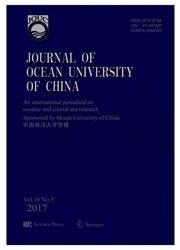

 中文摘要:
中文摘要:
根据2009年7、8月(夏季)、12月到翌年1月(冬季)、2010年11月(秋季)和2011年4、5月(春季)共4个航次在东海陆架区进行的现场多学科综合调查,报道了4个季节在整个东海海域的浮游植物的空间分布及群落结构特征,并探讨了影响其分布格局的环境因子效应。结果表明,东海浮游植物群落主要由硅藻、甲藻组成。共检出浮游植物5门88属299种(含未定种)。调查区夏季细胞丰度达最高,平均为(8 659.572±28 937.27)cell/L,其次是秋、冬季,春季最低,分别为(4 413.726±12 534.573)cell/L、(421.773±647.532)cell/L和(218.479±265.897)cell/L。硅藻细胞丰度在夏、秋、冬3个季节占总平均丰度的95%以上,甲藻细胞丰度在春季最高,占总浮游植物细胞丰度的69%。调查海区浮游植物丰度高值区主要集中在长江口海域,并向外海呈递减趋势。不同群落间存在季节更替和演替现象。物种丰富度自春夏秋冬逐渐升高。香农指数(Shannon-Wiener index)和均匀度指数(Pielou index)分布较为一致,物种丰富度指数(Margalef index)呈现时空分布差异。Pearson相关分析结果表明:不同季节的物种间更迭与海区特定的物理化学参数显著相关。
 英文摘要:
英文摘要:
Multidisciplinary investigations of phytoplankton community in the continental shelf regions of East China Sea (ECS)were performed during four cruises between year 2009-2011 (summer 2009,winter 2009,autumn 2010 and spring 2011).The present study reported the phytoplankton species composition,community structure,its dis-tribution in the ECS in four seasons,and its responses to environmental factors.Phytoplankton in the ECS were mainly composed of diatoms and dinflagellates.A totally,299 taxa (including under defined species)belonging to 88 genera and 5 phyla were identified.The phytoplankton cell abundance was highest in summer,its average was (8 659.572±28 937.27)cell/L,they decreased in turns in autumn,winter and spring.The average of phytoplank-ton cell abundance was (4 413.726±12 534.573),(218.479±265.897)and (421.773±647.532)cell/L in these three seasons respectively.Diatoms were the major component for the phytoplankton community in three seasons without spring.They took over 96% of the total phytoplankton cell abundance in these three seasons.In spring, dinoflagellates dominanted the whole community occupying 69% of phytoplankton total cell abundance.The high phytoplankton cell abundance appeared near by the Yangtze River Estuary waters,and decreased in offshore reigons.The phytoplankton community displayed species succession and seasonal variations.The species richness was increased in the order of spring,summer,autumn and winter.Shannon-Wiener index and Pielou index shared a similar trend.Margalef index varied with spatio-temporal dimensions.Pearson correlation analysis revealed that phytoplankton community alternating was strongly associated with specific physic-chemical environments.
 同期刊论文项目
同期刊论文项目
 同项目期刊论文
同项目期刊论文
 First record of a large-scale bloom-causing species Nannochloropsis granulata (Monodopsidaceae, Eust
First record of a large-scale bloom-causing species Nannochloropsis granulata (Monodopsidaceae, Eust Top-down control of spring surface phytoplankton blooms by microzooplankton in the Central Yellow Se
Top-down control of spring surface phytoplankton blooms by microzooplankton in the Central Yellow Se Increasing the quality, comparability and accessibility of phytoplankton species composition time-se
Increasing the quality, comparability and accessibility of phytoplankton species composition time-se 期刊信息
期刊信息
